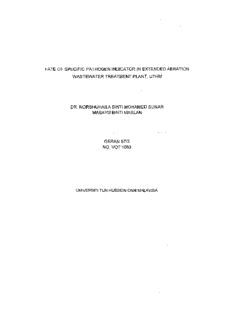
FATE OF SPECIFIC PATHOGEN INDICATOR IN EXTENDED AERATION WASTEWATER ... PDF
Preview FATE OF SPECIFIC PATHOGEN INDICATOR IN EXTENDED AERATION WASTEWATER ...
FATE OF SPECIFIC PATHOGEN INDICATOR IN EXTENDED AERATION WASTEWATER TREATMENT PLANT, UTHM DR. NORSHUHAILA BlNTl MOHAMED SUNAR MASAYU BlNTl MASLAN GERAN STG NO. VOT 1083 UNlVERSlTl TUN HUSSEIN ONN MALAYSIA ABSTRACT Pathogen indicators normally used in water quality indicator because large numbers of the bacteria are always present in the faeces of humans, but are not naturally found in water. Since these bacteria don't live long in water once outside the intestine, their presence in water means there has been recent contamination through effluent discharges or other sources. Like other enteric pathogens, a common mode of transmission for E.coli is via contaminated water, food and by direct person to person contact. Infection often causes severe bloody diarrhea, abdominal cramps, and possibly fever. In some cases, infection can lead to kidney failure and possibly death. In order to evaluate the efficiency of extended aeration wastewater treatment plant (EAWWTP), the microbial analysis such as enumeration of E.coli and total coliform were measured. Besides, this study also involved the measurements of pH, turbidity, DO (Dissolve Oxygen), BOD (Biochemical Oxygen Demand), COD (Chemical Oxygen Demand) and SS (Suspended Solid). This study summarized that each treatment process gives important roles to overall efficiency of EAWWTP. The secondary treatment was proved sufficient not only on reducing pathogen indicators but for all examined parameters. Significantly, this study conclude that numbers of pathogen indicators discharges in effluent meet the regulated standard guideline after treated through the EAWWTP. ABSTRAK Petunjuk patogen digunakan sebagai penunjuk kualiti air kerana sejumlah besar bakteria sentiasa hadir dalam najis manusia, tetapi tidak secara semulajadi terdapat di dalam air. Oleh kerana bakteria ini tidak hidup lama dalam air sekali di luar usus, kehadirannya di dalam air bermaksud terdapat pencemaran yang hadir melalui pelepasan effluen atau sumber-sumber lain. Seperti lain-lain patogen enterik, cara biasa penghantaran adalah melalui air tercemar, makanan dan manusia kepada manusia secara langsung. Jangkitan sering menyebabkan cirit-birit berdarah teruk, kram perut, dan mungkin demam. Dalam beberapa kes, jangkitan boleh membawa kepada kegagalan buah pinggang dan kemungkinan kematian. Dalam usaha untuk menilai kecekapan loji rawatan air sisa pengudaraan lanjutan (EAWWTP), analisis mikrob seperti penghitungan E.coli dan jumlah koliform diukur. Selain itu, kajian ini juga melibatkan ukuran pH, kekeruhan, DO (Oksigen Terlarut), BOD (Keperluan Oksigen Biokimia), COD (Keperluan Oksigen Kimia) dan SS (Pepejal Terampai). Kajian ini diringkaskan yang setiap proses rawatan menyediakan peranan penting kepada keberkesanan keseluruhan EAWWTP. Rawatan sekunder telah membuktikan bahawa bukan hanya mencukupi dengan mengurangkan petunjuk patogen tetapi untuk semua parameter juga perlu diperiksa. Secara signifikan, kajian ini menyimpulkan bahawa jumlah peiepasan penunjuk patogen dalam efluen memenuhi garis panduan standard terkawal selepas dirawat melalui EAWWTP. viii LIST OF TABLES NO. TITLE PAGE Table 2.1 Composition of human feces and urine (Mara, 1994) Table 2.2 Typical composition of untreated domestic wastewater (Metcalf and Eddy, 2004) Table 2.3 Typical of Organisms of Untreated Domestic Wastewater (Metcalf and Eddy, 2007) Table 2.4 Typical and Number of Microorganisms of Untreated Domestic Wastewater (Metcalf and Eddy, 2007) Table 2.5 Parameter Limits of Effluent of Standard A and Standard B (Environment Quality Act, 1974) Table 2.6 The Interim Marine Water Quality Standard (IMWQS) (DOE Report, 2006) Table 2.7 National Water Quality Standard for Malaysia (Source : EQR2006) Table 2.8 Water Classes And Uses(Source : EQR2006) Table 3.1 Sample Concentration Range and COD Digestion Reagent Vial Types Table 4.1 Parameter Standard (Parameter Limits of Effluents of Standards A and B (DOE, 2006); National Water Quality Standard for Malaysia (Source : EQR2006)
Description: